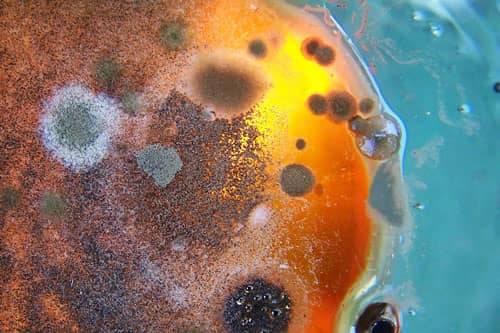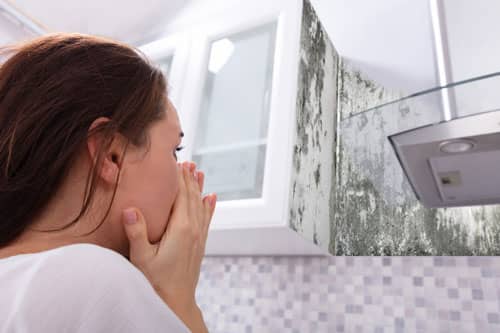Dealing with water damage is stressful enough, but to think that water damage can cause mold in your home or business can be overwhelming. After you have experienced water damage, it is important to get started on the water damage restoration process as quickly as possible in order to prevent mold growth. This will also help to prevent any further damage from the water damage itself. All Dry can assist you with your water damage restoration, and offers 24/7 emergency services so we will always be available after you have experienced water damage in your residential or commercial property. If you happen to also have mold due to the water damage you have faced, All Dry can also help you to rid your home or business of mold. Before we get into how to prevent mold growth after water damage, let’s discuss why water damage causes mold to begin with.
WHY DOES WATER DAMAGE CAUSE MOLD GROWTH?

A major concern with water damage is mold growth. All Dry understands why mold growth is so common and how to prevent it. It can quickly spread throughout a building or home, causing health problems and structural damage.
It is important to note that any type of water damage will be able to cause mold growth in any environment, including inside your home. Mold requires three things in order to grow: moisture, food, and a favorable temperature. Water damage provides all three of these things, creating the perfect environment for it to grow.
There are several ways in which water damage can provide moisture when it occurs. Excess water can be introduced into the home by a burst pipe, leaky roof, or storm flood. It is also possible for moisture to be produced by condensation and humidity, which build up in poorly ventilated homes.
There are many kinds of mold, and if certain materials become wet, they may provide the “food” that mold needs to grow within your home or business. Mold feeds on organic materials such as wood, drywall, wallpaper, fabrics, and carpeting.
It is not uncommon to find mold in bathrooms and basements, where humidity levels tend to be high and temperatures are warm. Mold thrives in warm, damp environments.
We at All Dry know that water damage can lead to mold growth, which is why it is crucial to act promptly if water damage occurs. The longer water sits, the more likely mold is to grow. The water can be extracted and the affected area dried out by All Dry, so that mold can be stopped before it begins.
HOW TO PREVENT MOLD AFTER EXPERIENCING WATER DAMAGE
It is important to take appropriate steps to prevent mold growth if water damage occurs in your home or business. Not only can it cause major structural issues, but it can also cause serious health issues if not addressed quickly. In order to prevent mold growth after experiencing water damage, it is extremely important to take proper steps. The best thing you can do to help prevent mold growth is contact All Dry right away to get started with the water damage restoration process, since mold only needs about 24 hours to begin growing after water damage has occurred.

All Dry specializes in water damage restoration and mold removal and offers expert advice on how to prevent mold growth after water damage. Here are some steps we recommend to prevent mold growth in your home:
Identify The Source Of The Water Damage
It is essential to address the source of the water damage in order to prevent mold from growing after water damage has occurred. In order to prevent mold growth, the cause of water damage must be identified and repaired as soon as possible. If not, the problem will only worsen and could lead to mold growth.
Water Removal and Drying/Dehumidifying the Area Affected
As soon as the water damage has been addressed at the source, it is imperative that your home be dried out as soon as possible in order to prevent further damage. Removing the standing water will be an important step in this process, as well as drying and dehumidifying the space to eliminate any excess moisture. You can accomplish this by opening windows, opening doors, running fans, and using dehumidifiers. You should also remove any damaged carpets, furniture, and other materials. If you allow your home to remain damp and humid, mold can grow in your home.
Clean and Disinfect
As soon as the water has been removed and your home is dry, the area should be cleaned and disinfected in order to help stop the chances of mold growth, and to rid your home of other bacteria that the water may have left behind. All Dry will assist you with this step of the process by using special cleaning solutions to prevent mold growth and other bacteria and viruses.
Monitor Moisture Levels and Humidity
Keeping your home’s moisture levels under control is important if you want to prevent mold growth. It is important to keep the humidity levels low (lower than 50%) if they are too high to prevent mold growth. Using industry-standard equipment, such as industrial fans and dehumidifiers, All Dry will restore your humidity levels after water damage has occurred. Using special monitors and technology, we make sure moisture levels are back to normal, which would be impossible if you were just relying on your senses.
Promote Air Circulation
Mold growth can be minimized by proper air circulation. Aside from the fans and dehumidifiers mentioned above that All Dry uses, you can also use fans, your HVAC system, and even open your windows to promote good circulation in your home after the water damage restoration process is complete to prevent high levels of humidity and moisture. During cooking, showering, or boiling water, exhaust fans are especially important in kitchens and bathrooms.
As a water damage restoration company, we know how important it is to prevent mold growth. You can help keep your home safe and healthy by following these steps. Most importantly, contact your trusted water damage restoration company in order to assist you with water damage repair as quickly as possible. Contact us if you need assistance with water damage restoration or have any questions.

